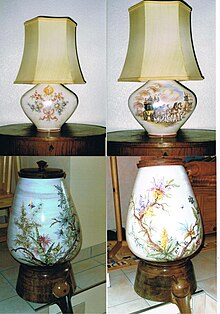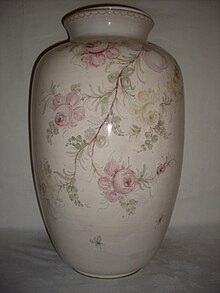Ulm ceramics
The Ulmer Keramik ( UK ) manufactory based in Ulm , later Neu-Ulm , started producing crockery, tiles and promotional items made of ceramics from 1947 onwards. In 1991 the company was closed.
Company history
The manufactory was founded by Heinz Saur (born November 6, 1916 in Essen, † November 9, 1962 in Neu-Ulm) and entered it in the municipal trade directory of Ulm on June 7, 1946 . After the renovation and expansion of Fort Prittwitz in Ulm, the production of tableware in red-brown shards began there in early 1947 . UK was entered in the commercial register on December 19, 1947.
From 1947/1948 hand-painted majolica were mainly produced. According to the Chamber of Commerce and Industry, the UK had 25 employees on January 13, 1948, mostly displaced persons from Silesia and Bohemia. Among them was the head of painting, Baroness Sybille von Rotkirch, who had studied art and painting in Berlin. As early as April 1948, the municipal trade office had 50 to 60 employees. After the currency reform in 1948 there were initial sales difficulties. After this crisis, the company picked up again. In 1952 it took over the machine park of WMF Geislingen. In 1954 200 employees were employed, 60 artists painted up to 1500 pieces of the approx. 130 articles with different decorations every day. The motifs were popular: fauna and flora, costumes, landscapes around the Mediterranean, from Paris, the Orient and the Far East. Facades and interior walls of well-known breweries, restaurants and cafés were decorated with hand-painted tiles. Almost everything was made for everyday use and to beautify the home. In 1954 UK was one of the largest majolica factories in the FRG with 15 modern kilns (electric spiral kilns). 40% of the production was exported to Europe, USA and Canada. For the first time a German ceramics manufacturer reached the world market suppliers Netherlands and Italy.
In 1956 the UK had increased the capacity to 17 kilns. 260 people produced 6,000 to 10,000 articles a day; The UK was thus the largest majolica factory in the Federal Republic. From the mid-1950s onwards, major companies had promotional items produced in runs of up to 50,000. The decoration of mass production to this extent was only possible with screen printing . The designs for this came from Ernst Konrad, who stayed with the UK from his apprenticeship to retirement. Hand painting was retained for smaller quantities.
UK had to expand for operational reasons. Since this was not possible in Ulm, construction was carried out in Neu-Ulm. The new plant was opened on July 11, 1959. After Saur's death on November 9, 1962, the authorized signatory Albin Blechschmidt, the former general manager Rudolf Mezger and Hans Forstner from Neu-Ulm - a war comrade Saurs - inherited the company in equal parts. The company was transformed into a limited partnership on August 30, 1963. Mezger left in 1964 and the company's headquarters were relocated to Neu-Ulm. In the period from 1977 to the end of the 1980s, sales halved. In 1985 Forstner also left the company and his son Johannes Forstner became operations manager. In the same year, Blechschmidt sold his share to Dr. Erich Merckle from Ulm. He took over the management together with Johannes Forstner. At that time there were still 55 employees at UK. Due to the cyclical decline in promotional items and imports from Asia, sales fell sharply. In 1990 the management decided to give up operations.
A clearance sale took place from March 1 to March 28, 1991. Operations ended on March 31, 1991. Most of the factory equipment was sold to Elster-Keramik GmbH in Elsterwerda .
Web links
swell
- Markus Horst: Ceramics of the 50s: shapes, colors and decors; a manual . Arnoldsche Art Publishers, Stuttgart 2005, ISBN 3-89790-220-6 , p. 78 ff., 404, 447, 508 ff .
- Wilhelm Krichbaum: Ulmer Keramik - The Manufactory and its Faience . Lichtenfels 1998 (documentation on 140 pages, to be viewed in the Ulm city archive).
- Saur, Heinz. In: Frank Raberg : Biographical Lexicon for Ulm and Neu-Ulm 1802–2009 . Süddeutsche Verlagsgesellschaft im Jan Thorbecke Verlag, Ostfildern 2010, ISBN 978-3-7995-8040-3 , p. 552 .
- Information from the last company owner Johannes Forstner, Ulm; the technical manager, ceramic master Herbert Häusler from Friedberg and ceramic engineer Horst Geiger from Pfaffenhofen an der Roth; by designer Ernst Konrad from Pfaffenhofen an der Roth, specialist in steel engraving and screen printing; the head of painting Sybille Baronin von Rothkirch; the designer and sample painter Ms. Raab, the sample painters Ms. Jäntsch and Ms. Hinrichsen and Mr. Supernok from Ludwigshafen.
- File for business registration and de-registration of the city of Ulm, B121 / 003, Ord. 131, 397; Ulm City Archives.
- Newspapers
- O. Peter Bühler: Europe's most popular majolica ceramics - made in Ulm. In: Ulmer Nachrichten. December 10, 1954.
- Ulmer ceramics has achieved a worldwide reputation in 10 years (kp). In: Schwäbische Donauzeitung. 17th December 1956.
- Largest majolica factory in the Federal Republic (kp). In: Schwäbische Donauzeitung. December 22, 1956.
- Ulm ceramics now also in Neu-Ulm (eh). In: Schwäbische Donauzeitung. July 13, 1959.
- Factory owner Saur died (zh). In: Schwäbische Donauzeitung. November 12, 1962.
- Manufacturer Heinz Saur † (sr). In: Neu-Ulmer Zeitung. November 12, 1962.
- Achim Feist: Insufficient market opportunities for products from Ulmer Keramik. In: Südwest Presse Ulm. February 22, 1991.
Remarks
- ↑ a b c Raberg, p. 552.
- ↑ a b W. Krichbaum: Ulmer Keramik - The Manufactory and its Faience. 1998, p. 5 ff.
- ↑ W. Krichbaum: Ulmer Keramik - The Manufactory and its Faience. 1998, p. 13.
- ↑ File for business registration and de-registration of the city of Ulm, file B121 / 003, Ulm city archive, statement on setting up a business to sell its own products from April 21, 1948.
- ↑ a b c O. Peter Bühler: Europe's most popular majolica ceramics - made in Ulm. In: Ulmer Nachrichten. December 10, 1954.
- ^ Swabian Danube newspaper. December 22, 1956.
- ^ Swabian Danube newspaper. July 13, 1959.
- ^ Swabian Danube newspaper. and Neu-Ulmer Zeitung. November 12, 1962.
- ↑ W. Krichbaum: Ulmer Keramik - The Manufactory and its Faience. 1998, p. 81.
- ↑ File on the registration and deregistration of business by the city of Ulm, file B121 / 003, Ulm city archive, excerpt from the official gazette No. 38 of September 19, 1963.
- ↑ File on the registration and deregistration of business by the city of Ulm, file B121 / 003, Ulm city archive, excerpt from the Official Gazette No. 44 of October 29, 1964.
- ↑ W. Krichbaum: Ulmer Keramik - The Manufactory and its Faience. 1998, p. 88.
- ↑ Südwest Presse Ulm. February 22, 1991.
- ↑ W. Krichbaum: Ulmer Keramik - The Manufactory and its Faience. 1998, p. 133 f.





